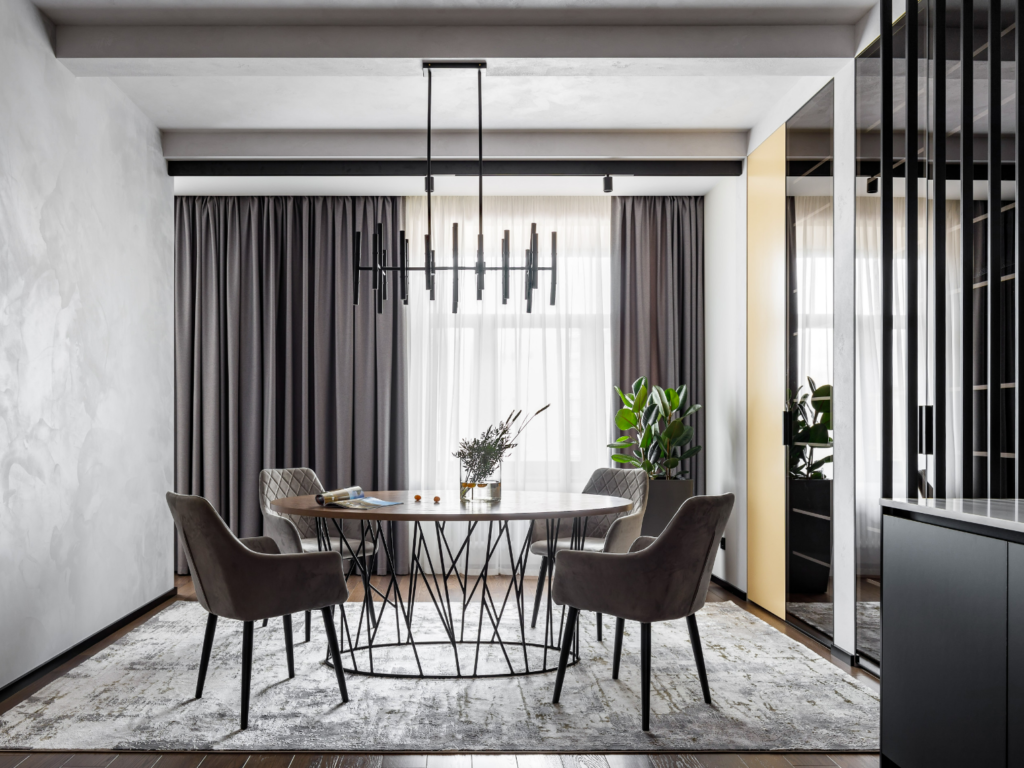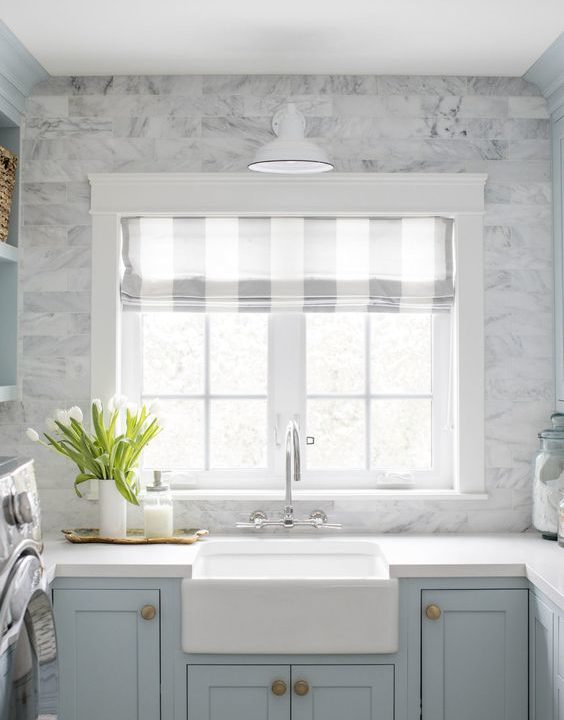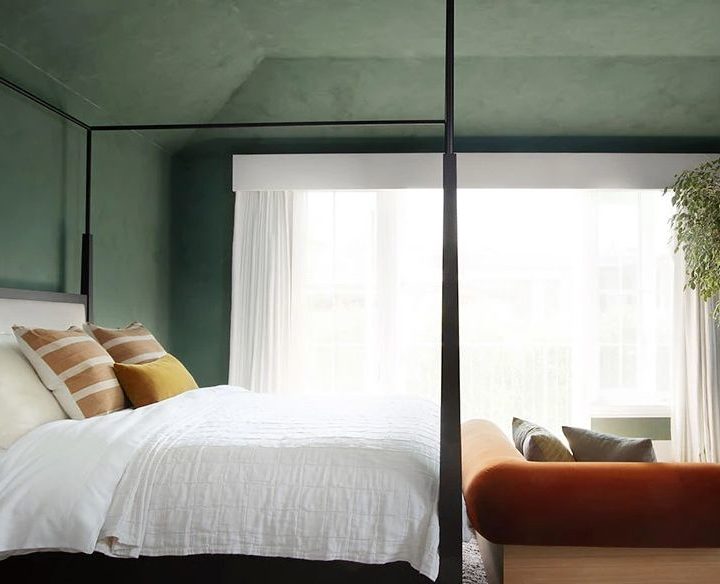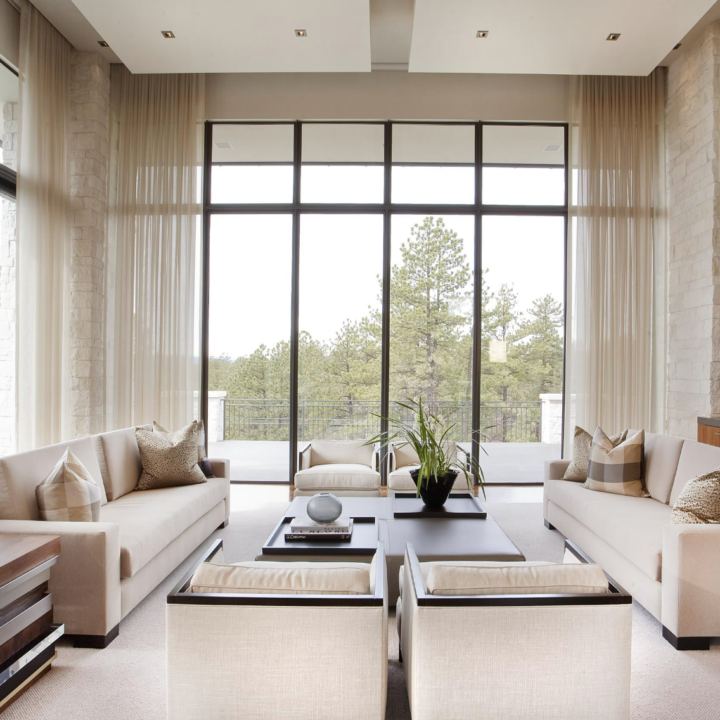Spiffy Speak
DINING ROOM CURTAINS & DRAPES: IDEAS & TIPS

Image by AI Interior Studio
The dining room is often a special place in the home. It’s a gathering space for friends and families to celebrate important occasions, enjoy the company of one another, and indulge in delicious meals. However, your dining room needs to be decorated in a thoughtful manner to serve as a welcoming backdrop for these special moments!
With this goal in mind, we welcome you to use our top dining room curtain ideas & tips below to dress your dining room windows.
Order custom curtains and drapes from Spiffy Spools online in any size. Pick from over 3,000 fabrics and patterns!
Top Five Tips for Dining Room Curtains

Image by Lee Ledbetter & Associates
When shopping for dining room curtains, one can often be fazed by choice overload and the bombardment of visual inspiration. What you need though is guidance on how to interpret designing rules for your situation. We have simplified the process for you by explaining the five important matters to be addressed when choosing dining room curtains.
Ask yourself five questions given below, and when you’ve finished with the fifth one, you’ll have envisioned your perfect dining room curtains. You then only have to go forth, browse our extensive collection and find the drapery that fits that vision. So, take a notepad, and start jotting down the answers and ideas that cross your mind as you read further.
READ MORE: BEST ROMAN SHADES FOR DINING ROOM
Formal or Casual?

Image by Kristofer Johnsson
When designing curtains for the dining room, you first need to identify whether the space features a more formal or casual feel. Is it a space where the family gathers for meals every day and which doubles up sometimes as a home office or homework zone for kids? Or, is it a more grandly arranged tucked aloof room that’s set apart for festive gatherings while daily dining happens on the kitchen island or the like? Or, is it a dining room that works very hard to meet the two diverse demands? Answering these questions can help you decide on a suitable style of curtain that best matches the atmosphere of the room:
- For a formal dining room, velvet and silk are the most opulent fabrics. They exude elegance and can be styled suitably in standard floor-length pinch pleat headings. Complete with ruched valances and glam hardware, this inviting and show-worthy window dressing is just right for a space meant to entertain. Our Blue Regal velvet curtains, for example, are perfect for a dressed-up dining room.
- For a semi-formal dining room, cotton curtains can easily be dressed up or down to perfectly match your current décor. When designed correctly, they can offer a well-balanced look that’s not overly formal yet still slightly more structured. For example, see geometric patterned Oymak curtains from our collections which when styled in full length flat panel tops exude a pared back elegance. Or get self-striped Daybreak curtains in back tab tops for a slightly more dressed up look.
- For a casual dining room, linen and sheer curtains are gorgeous options. Stitched in one of our casual heading styles, they’ll keep the space feeling light and fresh to add to its laid-back design. Like our Acik linen curtains that when styled as tab tops add casual flair to the space. Butter Cream curtains with their light weave and tiny embroidered floral patterns are both easygoing and light filtering.
SHOP NOW: CUSTOM WINDOW VALANCES & SWAGS FROM SPIFFY SPOOLS
Short or Long?

Image by Douglas Friedman Photography
Next, you need to decide on the length of your curtains for the dining room.
Short curtains include cafe curtains, sill-length curtains, and apron curtains. These are perfect for casual spaces like kitchens and dining rooms and their length proves handy in bathrooms and kids’ rooms. This is how we define them based on the length –
- Cafe curtains are hung at half the length of the window and brush the sill.
- Sill-length curtains cover the whole window and brush the sill.
- Apron curtains reach a few inches below the sill.
Long curtains reach the floor and bring out the elegant best of drapery. They can further be classified as floor-length drapes that float, kiss, break-puddle, or puddle.
- Floating curtains stand an inch above the floor.
- Kissing curtains barely brush the floor.
- Puddled curtains touch the floor and extend anywhere between 1 -16 inches. For more guidance on the various styles of puddling, refer to our blog post here.
Now that you know the various standard lengths in which curtains can be stitched, take note of how they suit particular situations better.
You should hang short curtains if:
- Your dining room gets a lot of foot traffic. Long curtains can present a tripping hazard. If you have children and pets who like to run around the house or many people pass through the area, short curtains that end at the windowsill can eliminate this potential danger.
- You’re concerned about wear and tear. Curtains that touch the sill will encounter much less abrasion than long curtains that touch the floor.
- You don’t mind a slightly more casual look. Short curtains are generally more casual in design. That’s not to say they can’t work at all in formal spaces, just note that there are other more formal lengths out there to choose from.
- The space beneath the window is engaged. You have a seating arrangement or radiator right below the window that hinders floor-length drapes.
You should opt for long curtains if:
- You want a completely formal look. Long curtains that touch the floor make a dramatic statement that’s undeniably regal. This is especially true of puddled curtains that allow the fabric to rest on the floor in gorgeous bundles.
- You want your dining room ceiling to appear bigger. Having one design element in the room that guides the eye upward helps to grasp the vertical space. Thus, hanging long curtains is known to make smaller spaces appear larger than they are. You can intensify this effect by hanging extra-long curtains higher than the window frame, or even going with floor-to-ceiling curtains.
- You don’t mind washing your curtains more frequently. Since long curtains hang close to or on the floor, they may need a bit more maintenance, requiring you to wash or dry clean your curtains on a regular schedule.
Stand Out or Blend In?

Image by Simon Brown Photography
Another point you need to consider is whether you’d like your curtains to be the focal point of the dining room or blend in with your surrounding décor. If you already have an arresting feature such as a rustic fireplace or grand wall art, you may want your curtains to step back and sink into the design. But if your dining room lacks a focal point, you can make your windows one.
Here’s how to make your curtains stand out:
- Select a bold color. Going with a unique, rich, and vibrant hue that stands out amongst the rest of your décor is a great way to ensure guests’ eyes are drawn to your curtains. You can pick a color from the tableware or the upholstery and echo that in a stronger tone through the curtains. Like, Mandarino silk curtains whose strong orange tone knows how to get attention.
- Select a medium to large-scale pattern. Patterns always arrest the eye, and more so, if they are grand-sized. If you’d like to hang patterned curtains, a medium or large-scale pattern such as London in Blue cotton curtains will make a bold statement in your space.
- Layer your window treatments. This method is a foolproof method to make your curtains a showstopper. You can make a combination of a highly functional pair such as roman shades and curtains or a mix of functional and decorative such as curtains and valances. Or let the curtains take up the ornamental role in stationary mode and let fully functional roman shades take up the whole responsibility of providing light control.
Here’s how to make your curtains blend in:
- Select a neutral solid color. Neutrals such as white, grey, beige, tan, and brown will tone down the look of your curtains, ensuring they blend nicely into the space. Notice how Tapakiri linen curtains’ light beige sync into your decor letting other elements to be the star of the show. And, if they are the same color as the walls, they will seem like a part of the architecture itself.
- Go with small-scale patterns. Even if you want your curtains to blend in, you can still select a gorgeous pattern. Simply ensure that it’s a small-scale pattern that features a more delicate design. For inspiration, check out Morlaix cotton curtains that has a slender vine motif with subtle tonal variation.
SHOP NOW: CUSTOM ROMAN SHADES FROM SPIFFY SPOOLS
Frequently or Rarely Used?

Image by Tracy Hardenburg Designs
When it comes to functionality, light control might be more important than privacy in a dining room. And if your window is not too exposed to the hot sun, light control might have to only go as far as cutting off the glare. And there are times when the sun’s glow is soft and soothing and you want to draw open the curtains to enjoy it in your dining space. Therefore, understanding how frequently you will operate your dining room curtains also plays a key role in your curtain choices:
- If you will rarely operate your dining room curtains, and privacy is not a major concern, consider opting for two stationary curtain panels that hang on either side of the frame serving purely as a decorative element. Stationary panels will beautifully accent the window and never cover it off, blocking light or air.
- If you will operate your dining room curtains often, we suggest hanging standard, fully operational curtains. Remember to measure length accurately and order panels that are wide enough to have full gather and sumptuous pleats. Also, consider curtains that employ rings/pins or grommets so they may glide easily on the drapery pole. Whereas, you may avoid styles like rod pockets and back tab tops that hang on fabric loops and may not afford such ease.
Detailed or Simple Heading?

Image by Christina Kim Interior Design / Raquel Langworthy
Not just the functional aspect, but also the visual appeal is affected greatly by the heading style of the drapery. That also has an impact on the overall bearing of the dining room. Depending on the overall design and the nature of the space, you may select a suitable curtain heading style.
- Detailed and ornate: Traditionally designed homes have a befitting find in curtains that have elaborate details. Curtains like triple pinch pleats have an architectural construct and flowery pinch folds that are most suitable for formal rooms. Goblet pleated draperies that look still more grand are apt for classically-designed, ultra-formal spaces. Whereas, more pared-down traditional spaces and transitional styles are well served with double pinch pleats, Euro pleats, or box pleats draperies. In a country-style dining room, frilled header rod pockets and pencil pleats draperies with their ruched headers are a perfect fit.
- Simple and delicate: Homes that worship modern design ethics of clean lines and minimal details should ideally go for heading styles that are simple in their construct. For example, flat panel tops have no pinched pleats on the header and are stitched with less fullness, rendering a very simplistic appeal. Grommet tops, tie tops, and tab tops are other such examples. Formal dining rooms look right in more architectural styles like ripple folds and back tab tops.
READ MORE: CURTAIN HEADINGS STYLE GUIDE
Order Custom Curtains from Spiffy Spools
We hope these top dining room curtain ideas & tips inspire you! If you’re ready to shop, order your custom curtains from Spiffy Spools today. We make it easy to design a window treatment that fits your exact specifications and design style. Explore our site to find the perfect options for your dining room, and don’t hesitate to contact us with any questions!
READ MORE: DINING ROOM WINDOW TREATMENTS: IDEAS, PHOTOS & TIPS



